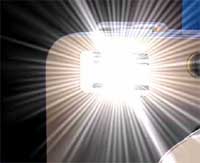Tips and Tricks: Flash
Using a Flash
That little flash is so misunderstood and most camera owners simply let the camera decide when it is time for a flash or not. Is "automatic flash" a setting you wish to use? There are good points to using flash just as there are bad points
So, using a built-in flash can make colors turn bland, cause red-eye, lose sharpness in an images background due to range limitations, is inconsistent and can actually make colors into something they are not. Oh Joy!
The general consensus is to NOT utilize a camera in an automatic flash mode and to only utilize flash in situations where you simply need to get rid of some shadows. One such place would be Outdoors in sunlight. Using a flash outdoors can help chase away shadows that can obscure detail in your images. This is known as "fill-in light" and can be a huge improvement.
But...But....But.... How do I get my indoor pictures to show up? Simple, add more natural lighting if possible. Open curtains or position the subject in a brightly lit area. Not possible? Turn on as many lights as possible and adjust aperture and white balance. There will always be circumstances where it is simply impossible to get enough lighting and any picture is better than none. At that point, the flash may be the only solution. Even then, using some tissue to lower the harshness or trying different angles and position can help achieve an adequate image.
Experimentation with different settings can be helpful as well in determining what settings and conditions work best.
That little flash is so misunderstood and most camera owners simply let the camera decide when it is time for a flash or not. Is "automatic flash" a setting you wish to use? There are good points to using flash just as there are bad points
|
The bad: * Flash can give a harsh light to your subject, thus changing the true colors * Compact Flash (built-in flash unit of a digital camera) can cause numerous issues: red eye, harsh lighting and lack of lighting for backgrounds since this style of a Flash is has a very short range. * Flash is never consistent due to battery drain. The more you use it, the less light output due to battery levels. * Fluorescent flash can change colors to the point green can look blue |
 |
So, using a built-in flash can make colors turn bland, cause red-eye, lose sharpness in an images background due to range limitations, is inconsistent and can actually make colors into something they are not. Oh Joy!
The general consensus is to NOT utilize a camera in an automatic flash mode and to only utilize flash in situations where you simply need to get rid of some shadows. One such place would be Outdoors in sunlight. Using a flash outdoors can help chase away shadows that can obscure detail in your images. This is known as "fill-in light" and can be a huge improvement.
But...But....But.... How do I get my indoor pictures to show up? Simple, add more natural lighting if possible. Open curtains or position the subject in a brightly lit area. Not possible? Turn on as many lights as possible and adjust aperture and white balance. There will always be circumstances where it is simply impossible to get enough lighting and any picture is better than none. At that point, the flash may be the only solution. Even then, using some tissue to lower the harshness or trying different angles and position can help achieve an adequate image.
Experimentation with different settings can be helpful as well in determining what settings and conditions work best.